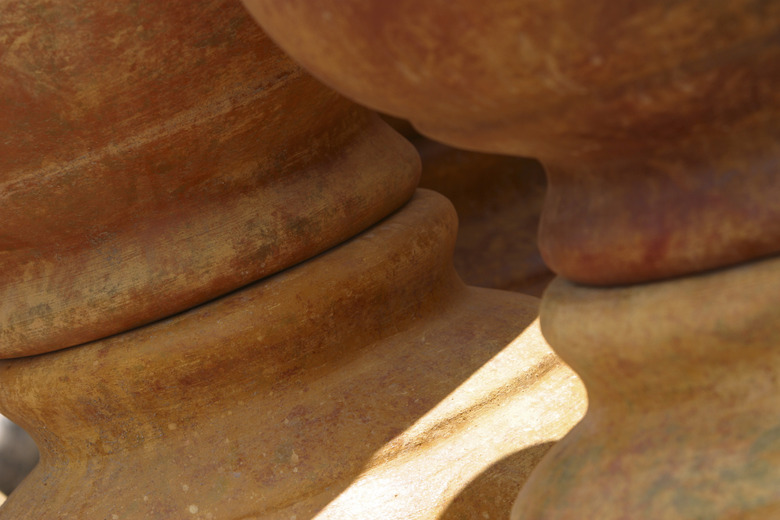What Is The White Powder On My Terra Cotta Pots?
Whether grown as houseplants or outdoors as potted trees, shrubs, flowers and vegetables, plants grown in terra cotta or unsealed clay pots sometimes develop crusty, white powder or residue both inside and outside. Salty crusts can also develop on plastic pots.
Whether grown as houseplants or outdoors as potted trees, shrubs, flowers and vegetables, plants grown in terra cotta or unsealed clay pots sometimes develop crusty, white powder or residue both inside and outside. Salty crusts can also develop on plastic pots. This powder is an accumulation of soluble salts and indicates that high salt levels are building up in the soil too — threatening the health and vitality of your plants. In a sense, that white powder is a helpful early warning signal. Fortunately, a few simple changes can turn things around.
Watering and Fertilizing Plants in Pots
The natural relationship among plant roots, soil, soil moisture and nutrients is dramatically changed by the confinement created by the container. Plants in containers need frequent watering compared to in-ground gardens due to limited soil volume and because pots' exposed sides lead to greater evaporation. Water when the top 1 or 2 inches of potting soil feel dry, saturating the potting soil. If there is some doubt that soil is thoroughly moist — if plants wilt quickly or if potting soil pulls away from the container's sides — occasionally soak pots in a sink or bathtub of tepid water to make sure the potting soil is fully saturated. Never soak plants for more than a few hours; also drain excess water from drain trays to avoid drowning plants by driving out all soil oxygen. Provide plant nutrients when you water in the form of water-soluble inorganic or organic fertilizers.
- Whether grown as houseplants or outdoors as potted trees, shrubs, flowers and vegetables, plants grown in terra cotta or unsealed clay pots sometimes develop crusty, white powder or residue both inside and outside.
- If there is some doubt that soil is thoroughly moist — if plants wilt quickly or if potting soil pulls away from the container's sides — occasionally soak pots in a sink or bathtub of tepid water to make sure the potting soil is fully saturated.
Soluble Salt Buildup in Clay Pots
Plants dry out sooner in clay pots than plastic containers, but the permeability of clay pots can be helpful — especially when removing soluble salts, which can build up in soil to toxic levels. When clay pots "wick away" moisture from the soil they contain, they also absorb soluble salts. These salts sometimes come from water high in carbonates, salts or other minerals. They also come from inorganic fertilizers — which potted plants generally need, because they are not grown in true soil — and sometimes also from potting soil mixes derived from animal manure.
Preventing Salt Buildup
Leaching or flushing out accumulated soluble salts is the best way to protect your plants' health and, eventually, eliminate the problem of salts building up on clay pots. Placing pots in a sink or on the lawn then watering them repeatedly — or, on the lawn, watering multiple pots simultaneously with an overhead sprinkler — can help dilute and flush excess salts from the soil. The process will have to be done periodically in most cases. Some people water with only rainwater or distilled water if the salt source is their irrigation water.
- Plants dry out sooner in clay pots than plastic containers, but the permeability of clay pots can be helpful — especially when removing soluble salts, which can build up in soil to toxic levels.
Removing Salt Buildup on Clay Pots
Soak salt-stained terra cotta pots — without potting soil or plants — for a few hours in vinegar to remove salt deposits. If pots are heavily salt crusted, soak them for 10 or 12 hours then scrub thoroughly with a steel wool cleaning pad. Before reusing cleaned terra cotta pots, sterilize them in a diluted solution of one part bleach and nine parts water for at least 10 minutes to remove any residual fungi or bacteria from previous use. Then rinse pots in clean water and allow them to dry.
